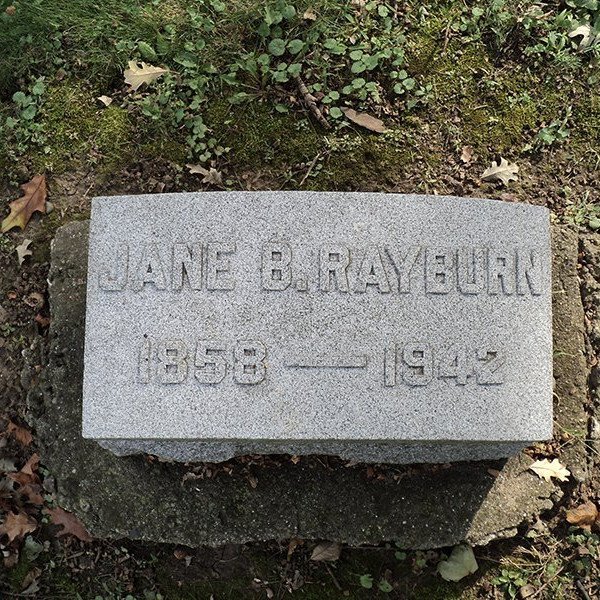Jane “Jennie” Buttolph Rayburn was born May 11, 1858 in Middlebury, Vermont a daughter of William Wallace Buttolph, and his wife Mary Ann. William was a railroad man and in 1859 he moved his family to Bloomington, Illinois where he worked for the Chicago and Alton (C&A) Railroad.
The family lived on East Grove Street and Jennie lived on this street for the rest of her life. If one phrase can describe Jennie’s life it would have been “typical Midwestern middle class.” She married, had children, participated in club work, became widowed, and lived out her years in the same quiet community where she grew up.
In 1870 Illinois Wesleyan University (IWU) admitted its first female students. In 1874, Jennie enrolled as a student there and it was probably there that she met her future husband, Calvin Rayburn.
The couple married in 1877 when she was 19 and he was 29. He was a school administrator then but later obtained a law degree and eventually became a well known attorney in Bloomington. They purchased a home on East Grove Street about 1884 and in 1885 their first son William Buttolph Rayburn was born. In 1889 they had a second son, Donald, who lived only until Easter Day in 1891. Jennie would commemorate his life and death every year thereafter and wonder what sort of man he would have become. A third son, Allan Barnes Rayburn, was born in 1892.
The national organization Daughters of the American Revolution (DAR) was founded in 1890. In 1894 the Letitia Green Stevenson Chapter of DAR was founded in Bloomington. Jennie became member #61 in 1896. Her great-grandfather Buttolph served in the Revolutionary War. A few years later she became the Chapter’s Historian and then she was Registrar for many years.
In 1917 the United States entered World War I. Jennie and Calvin had a personal interest in the events of the war as their son Allan was a Lieutenant in Aviation at Love Field in Texas.
Calvin died in September 1924. Jennie’s diaries cover the years of her widowhood 1925-1942 when she was 66-84 years of age. The diaries record her “typical” life as a widow. Her sister, Isadora Brown, had lived with her and Calvin and continued to be her companion after his death so she was not alone in her home. Her days were filled with routine activities such as reading the newspaper, listening to the radio, walking downtown for shopping, sewing, visiting with friends, reading, writing letters, and attending to normal household duties.
Jennie became a grandmother in 1928 with the birth of Willa (daughter of son Allan). She would eventually have five grandchildren. Her diaries indicate that she was a loving and proud grandmother.
In November of 1928 came a traumatic event and one that Jennie would record in the diary three years later as “that event the most tragic of my life.” Her sister Isadora had gone across the street to visit a neighbor. As she was crossing the street in the dark to return home, she was accidentally struck and killed by a passing automobile. Jennie mourned the loss of her sister and from that point on would live alone in her Grove Street home. She recorded, “I am the last of my family of my generation!”
Jennie’s lifeline to local, national, and world events was the radio. Like other households across the nation, she spent hours listening to the radio and wrote of hearing presidents’ speeches, news, music, and various programs that kept her entertained and informed. Thus she wrote in her diary her own opinions and commentary on happenings of the day.
The stock market crash of 1929 and the resulting Depression brought about desperate times for many people and Bloomington was no different. Jennie had been making diary entries about friends whose husbands and sons were out of work, and the number of people coming to her door trying to sell something or asking for work or food. She wrote “One day I counted up each offer…it amounted to $1.00 besides a man asking for clothes, another something to eat.” She wrote that on average, such people came to her door at least three times a day. Even her son Allan had to ask her for financial assistance.
On February 7, 1931 Jennie met hard times when someone grabbed her purse and ran away with it. Luckily, she had less than $3.00 in cash but it was two months before she was able to recover such things as keys, a check, and her bank book, and other items which the thief had thrown away. She related her “holdup” stories at a DAR meeting and to other friends.
Jennie died in August 3, 1942 at St. Joseph’s Hospital where she had been admitted for two weeks due to illness. She was buried at Evergreen Memorial Cemetery in Bloomington, IL in the Rayburn family plot.
Rayburn, Jennie
(May 11, 1858 — August 3, 1942)
Written by . 5 min read.


MLA:
“Rayburn, Jennie.” McLean County Museum of History, 2006, mchistory.org/research/biographies/rayburn-jennie. Accessed 06 Jan. 2026. APA:
Rayburn, Jennie (2006). McLean County Museum of History, https://mchistory.org/research/biographies/rayburn-jennie Chicago:
“Rayburn, Jennie.” McLean County Museum of History. 2006. Retrieved from https://mchistory.org/research/biographies/rayburn-jennie
“Rayburn, Jennie.” McLean County Museum of History, 2006, mchistory.org/research/biographies/rayburn-jennie. Accessed 06 Jan. 2026. APA:
Rayburn, Jennie (2006). McLean County Museum of History, https://mchistory.org/research/biographies/rayburn-jennie Chicago:
“Rayburn, Jennie.” McLean County Museum of History. 2006. Retrieved from https://mchistory.org/research/biographies/rayburn-jennie